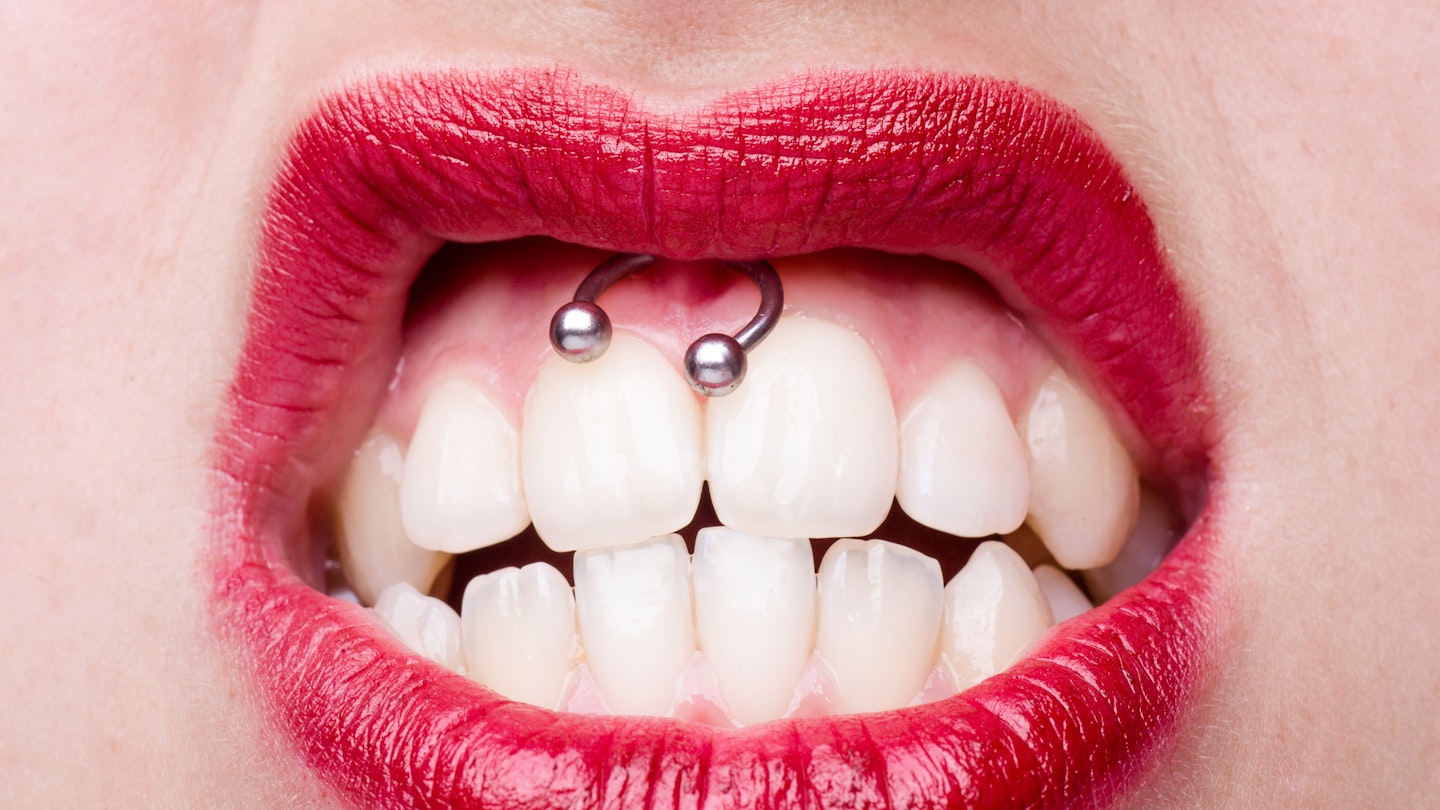If you're looking for a quirky piercing to give you a new lease of life... allow us to point you in the direction of the smiley piercing - which makes the infamous tongue piercingseem like old news (sorry Mum and Dad). Completely different from traditional piercingslike those around the ear, the smiley is located in the mouth (nowhere near the cheeks or dimples if you were thinking otherwise).
It's a piercing that will get you noticed when you smile, but can easily be covered with your top lip once your mouth is closed. If you're considering this unique piercing, we have a full guide of everything you need to know below.
What is a smiley piercing?
A smiley piercing passes through the part of your mouth that connects your upper lip and gum. The piercing can't be seen when your mouth is closed, hence the name - "smiley". Jamie Kelly, manager of Underground Tattoos in Watford, describes it as 'a type of oral piercing that goes through the frenulum. It's called a smiley piercing because it's only visible when someone smiles and sits above your front incisors and connects the gums to the lip.'
How is it pierced?
The piercing is done relatively quickly and it involves these four steps. Kelly explains:
-
The area is cleaned with alcohol-free mouthwash.
-
After your mouth is clean, the piercer will mark the entry and exit points for the piercing using a sterile marker or pen.
-
A sterilised needle then passes through the smiley from the inside of the mouth, while the piercer guides it out through the marked exit point on the upper lip.
-
Once the piercing is made, the chosen jewellery is swiftly inserted in, which is usually a 18 gauge horseshoe.
How painful is it?
Pain tolerance and thresholds vary from person to person. But you'll be glad to know most people experience little to no pain when it comes to this piercing. This is due the membrane the piercing goes through, it's relatively thin and has few nerve endings. Another plus is that that the procedure is also very quick but, this does not mean you should do it at home!
Kelly has had the piercing done and says the pain level sits at a six out of 10, 'a smiley piercing can be quite painful due to the sensitive nature of the area being pierced. It's often described as a sharp, intense pinch during the piercing process. but less painful than piercings in cartilage or nose.'
How much does it cost?
A smiley piercing can cost you anywhere between £20 to £40 and you will most likely be charged separately for the jewellery. At Urban Tattoos, smiley piercings costa around this much and depend on the ring the customer chooses, but this can vary from place to place.

What type of jewellery is used?
The best part! When you first get pierced, most piercers will use a captive bead ring which is a circular shape with a small ball. When the piercing is completely healed most people opt for circular barbell, this piece has a horseshoe shape with a bead on each end (it looks like a septum ring). Finally we have the seamless ring, which is the least common of the three, it connects without using a bead to hold it in place. Kelly recommends using 'titanium horseshoes or a ball captive ring, as the weight on the balls help to keep the jewellery in place.'
Healing time
The healing process for a smiley piercing can vary from person to person, but typically it takes about six to eight weeks for the initial healing to occur, says Kelly. During the healing process 'swelling, tenderness, and some bleeding may occur immediately after the piercing, but this usually stops within a few days. It's essential to maintain good oral hygiene during the healing process.'
Cleaning and care
It's essential that you follow up with proper care to ensure your piercing heals correctly. Most professional piercers recommend, you brush your teeth twice a day with a mild toothpaste and use saline solution or an alcohol-free mouthwash to rinse your mouth after eating and drinking to help keep the piercing clean.
Avoid these whilst the piercing is healing:
-
Spicy and hot foods
-
Alcohol
-
Smoking
-
Excessive touching
-
Kissing or oral sex
-
Acidic food
-
Crunchy food
-
Moving or playing with the jewellery unnecessarily
What are the risks associated with this piercing?
Although this piercing is super cool, it does come with some side effects if proper care is not followed. These include:
-
Wearing down teeth and gums: The jewellery rubbing on the teeth could potentially chip the enamel and damage soft gum tissue.
-
Speech issues: Its normal for speech to sound a bit different as you get use to your new piercing.
-
Accidental swallowing: If the piercing is not secure properly, you could also risk swallowing it.
-
Infection: This could be caused by improper aftercare.
-
Piercing rejection: Naturally your body may reject the piercing which may cause swelling. You may also notice the piercing slowly coming out the front of the frenulum.
To avoid these problems it's advised you get your piercing done professionally and follow the correct aftercare plan.
Do smiley piercings fall out easily and how long do they last?
According to Kelly, 'they can fall out but they don’t usually loosen unless they've been fiddled with,' that said it also depends on anatomy and your suitability to the piercing, which will determine if your body rejects it or not.
Due to its delicate placing inside the mouth, smiley piercings might not last as long as other external body piercings. But each case is different, some anecdotal reports found online as well as evidence from studios say that the piercing may last around a year, while others have enjoyed theirs far longer. Due to the thin membrane of the lip frenulum, some people may find that over time the piercing will naturally reject, making it an impermanent piercing.
How to choose the right piercer
Given the positioning of this piercing, the smiley (like many other piercings) should be approached with care. Body modifications should always be conducted by a professional. 'Choosing your piercer is important in making sure you are pierced in a safe, knowledgeable, sterile environment. Check out piercer’s socials, visit the studio and meet the piercer and word of mouth is always a great way of finding the best piercer for you. Make sure that the studio is health authority registered, too,' explains [head piercer at Laura Bond, Sarah Crowe.]{href='https://www.instagram.com/laura_bond_jewellery/p/CzeDXz5opF4/' }
The right piercer will also help to identify your suitability for the piercing, for instance, those with unsuitably sized frenulums, braces, or gum and oral issues should be prevented from getting the piercing.
Kelly adds that piercers need a personal license from the local council as well as a studio license. Additionally, hep vaccines, infection control and first aid are a must, but you don’t need a qualification to pierce so it’s important to research beforehand and opt for a professional and experienced piercer.

